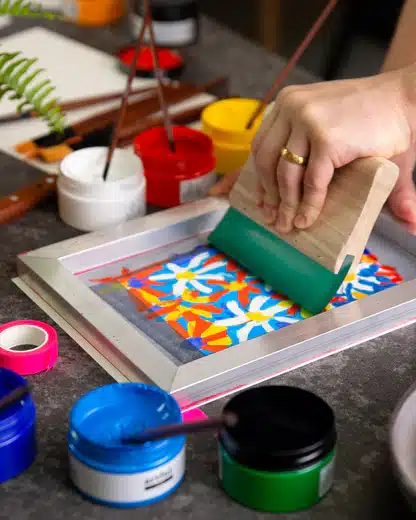The Difference Between Screen Printing and Live Printing
The Difference Between Screen Printing and Live Printing

In today’s competitive market, businesses are constantly seeking innovative ways to engage clients and create memorable experiences. One way to achieve this is through the art of printing, which has evolved significantly over the years. While screen printing has a rich history and is often considered the “father of printing,” live printing has emerged as a modern, dynamic alternative. This blog will explore the differences between screen printing and live printing, highlighting how each method can provide unique and enjoyable experiences for your clients.
Screen Printing: The Timeless Classic
A Historical Perspective
Screen printing, also known as silk screening, has a storied past that dates back to ancient China first appeared in a recognizable form in during the Song dynasty (960–1279 AD). This technique involves creating a stencil (or screen) and using it to apply layers of ink on a substrate, typically fabric. The process has been refined over centuries and is still widely used today for its ability to produce vibrant, durable prints.
The Process
Screen printing involves several steps:
- Design Preparation: Creating a stencil or screen for each color in the design.
- Screen Creation: Coating a mesh screen with a light-sensitive emulsion and exposing it to the design.
- Printing: Applying ink through the screen onto the material.
- Curing: Heating the ink to ensure it adheres properly to the material.
Advantages of Screen Printing
- Vibrant Colors: Screen printing produces bold, vibrant colors that can withstand repeated washes.
- Durability: The prints are long-lasting and can endure heavy use.
- Versatility: Suitable for various materials, including textiles, plastics, and metals.
Drawbacks of Screen Printing
- Complex Setup: The process requires multiple screens for different colors, making it time-consuming.
- Messy Process: Handling inks and screens can be messy and requires a dedicated space.
- Inconsistency: Slight variations can occur between prints, especially in large batches.
Live Printing: The Modern Innovator
The Rise of Digital Printing
Live printing, often associated with digital printing technologies, is a newer method that allows for on-the-spot customization and instant results. Unlike screen printing, live printing uses digital screens and printers to apply designs directly onto materials. This method has gained popularity for its convenience, speed, and ability to engage clients in the creative process.
The Process
Live printing typically involves:
- Design Creation: Using digital software to create or select a design.
- Printing: Directly printing the design onto the material using a digital printer.
- Finishing: Quickly curing the print to ensure durability.
Advantages of Live Printing
- Instant Gratification: Clients can see their designs come to life immediately.
- Clean Process: Digital printing is cleaner and more efficient, with no need for messy inks or screens.
- Unlimited Options: A vast array of colors, texts, and artworks can be printed without the need for multiple screens.
- Customization: Each item can be uniquely personalized, making it ideal for events and promotions.
Drawbacks of Live Printing
- Initial Costs: Digital printers can be expensive to purchase initially.
- Durability: While improving, digital prints may not always match the long-term durability of screen-printed items.
Engaging Clients with Printing Experiences
Screen Printing: A Nostalgic Journey
For clients who appreciate traditional methods and the craftsmanship involved, screen printing offers a nostalgic and hands-on experience. Workshops and demonstrations can showcase the intricate process, allowing clients to understand and participate in creating their items. This engagement fosters a deeper appreciation for the art form and creates memorable, tactile experiences.
Live Printing: The Interactive Future
Live printing, on the other hand, provides an interactive and modern experience. Clients can design their items using digital interfaces and watch their creations come to life in real-time. This instant gratification and the ability to customize on the spot make live printing a fun and engaging activity. It’s perfect for events where clients want to walk away with a unique, personalized keepsake.
Conclusion
Choosing between screen printing and live printing ultimately depends on the preferences of your clients and the nature of your events. Screen printing offers a timeless, durable, and vibrant option with a touch of historical charm. Live printing, however, provides a modern, clean, and highly customizable experience that can captivate and engage clients instantly.
By understanding the strengths and limitations of each method, you can tailor your approach to create unforgettable experiences for your clients. Whether you embrace the traditional craftsmanship of screen printing or the innovative convenience of live printing, the key is to offer an engaging and memorable interaction that leaves a lasting impression.
So, consider incorporating these printing techniques into your next event or client engagement strategy. Watch as your clients immerse themselves in the creative process, resulting in unique keepsakes and unforgettable memories.




